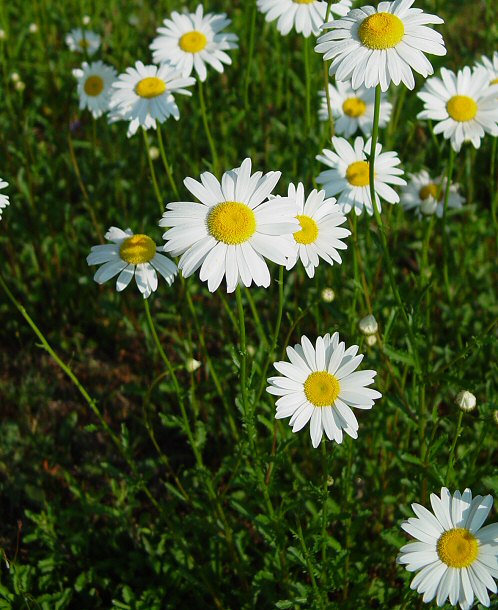Leucanthemum vulgare Lam.
Ox-Eye Daisy

Introduced
CC = *
CW = 5
MOC = 80
© DETenaglia
Leucanthemum vulgare Lam.Ox-Eye Daisy | |
 |
Introduced CC = * CW = 5 MOC = 80 |
© DETenaglia |
|
Family - Asteraceae/Anthemideae Habit - Rhizomatous perennial forb with fibrous roots. Stems - Ascending to erect, to 90 cm, unbranched or few-branched from near the base, finely ridged, sometimes finely hairy toward the tip when young, glabrous or nearly so at maturity.
Leaves - Alternate and basal (basal leaves sometimes withered by flowering time), the basal and lowermost stem leaves long-petiolate, grading abruptly to sessile leaves along most of the stem. Blades 1-12 cm long, narrowly obovate to oblong-oblanceolate, usually pinnately lobed (the lobes sometimes few-toothed) but sometimes only with coarse, narrow, rounded teeth; the main leaves usually clasping the stem and often with stipulelike lobes or teeth toward the base, rounded at the tip, the surfaces glabrous or nearly so, the lobes or teeth 7 to numerous, generally with 1 main vein.
Inflorescence - Single flower head terminating stem, the upper portion of the stem leafless. Heads - Radiate. Involucre 7-9 mm long, cup-shaped to broadly cup-shaped, the bracts usually in 3 loosely overlapping series, subequal (the innermost slightly elongate), lanceolate to narrowly ovate-triangular, bluntly to sharply pointed at the tip, glabrous, green to yellowish green, the midrib not keeled, the margins purple to brown, at least the margins and tip of the innermost bracts also thin and papery. Receptacle somewhat convex to nearly flat, usually hollow, naked.
Florets - Ray florets 15-35, pistillate, the corolla 10-20 mm long, white. Disc florets perfect, numerous, the corolla 2.5-3.0 mm long, yellow, glabrous, the 5 lobes without resin canals, persistent, the tube not flattened toward the tip or becoming swollen at fruiting. Pappus absent.
Fruits - Achenes 2.0-2.8 mm long, narrowly obovoid to nearly cylindrical, more or less circular in cross-section, truncate at the base and tip, with usually 10 rounded, light tan to white ribs, the surface otherwise glabrous, dark brown to nearly black and sometimes with minute, short, white lines. Flowering - May - August. Habitat - Prairies, glades, tops of bluffs, savannas, forest openings, pastures, fields, fencerows, railroads, roadsides, open disturbed areas. Origin - Native to Europe. Lookalikes - Matricaria chamomilla, Tripleurospermum inodorum; more broadly, Erigeron pulchellus. Other info. - This common daisy can be seen growing along roadsides throughout Missouri in the early summer. It is relatively easy to identify from the large, white-rayed flowering heads and leaves with coarse teeth on the margins. It is found, sparsely to commonly, thoughout the continental U.S. It can spread aggressively via rhizomes, and listed as a noxious weed in a number of states. Steyermark listed two varieties of the species in Missouri, based upon depth of leaf lobing. These phases intergrade and many authors choose not to make the distinction. A synonym for the species is Chrysanthemum leucanthemum. Photographs taken at off Hwy 106, Reynolds County, MO., 5-23-03, and off I-85 near Auburn, AL., 5-12-05 (DETenaglia); also at Shaw Nature Reserve, Franklin County, MO, 5-27-2015 and 5-20-2022 (SRTurner). |